Erythrina caffra
| Botanical Name | Erythrina caffra |
|||||||||||||||||||||
| Family | Fabaceae - The legume and pod-bearing family. (Pea & Bean Family) |
|||||||||||||||||||||
| Pronunciation | er-ith-RY-nuh KAF-fra |
|||||||||||||||||||||
| Common Name(s) |
English: Coastal Coral Tree; Cape Coral Tree; Lucky Bean Tree
Afrikaans: Kus-koraalboom; Kaapse Koraalboom
IsiXhosa: umsintsi
IsiZulu: umsinsi
|
|||||||||||||||||||||
| Plant Group |
|
|||||||||||||||||||||
| Plant Size |
|
|||||||||||||||||||||
| Position |
|
|||||||||||||||||||||
| General Information |
|
|||||||||||||||||||||
| Specific Information | Erythrina caffra has an attractive branch structure and a number of rounded heads forming a wide canopy. This tree is attractive in flower, in leaf and when leafless. It provides ideal light shade for many herbaceous plants, allowing them to receive a little more light during the cooler months. Erythrina caffra in full flower, before the leaves appear, is a spectacular sight and a magnet for a wide variety of birds that utilise the nectar, blossoms, seed and visiting insects, of which there are many. After flowering, the tree is festooned with black pods which burst open to reveal the bright red 'lucky bean' seeds. |
|||||||||||||||||||||
| Ad Break | ||||||||||||||||||||||
| Flowers | ||||||||||||||||||||||
| Description | large 'pea' flowers in clusters |
|||||||||||||||||||||
| Season |
|
|||||||||||||||||||||
| Colour |
|
|||||||||||||||||||||
| Growth Rate |
|
|||||||||||||||||||||
| Plant Uses |
|
|||||||||||||||||||||
| Distribution and Habitat | in the Eastern Cape and in a small area in northern KwaZulu-Natal, in wet, well-drained, humus-rich soils to dry, clayey soils |
|||||||||||||||||||||
| Planting Suggestions | Plant Erythrina caffra in sunny places in well-drained soil. It can tolerate quite moist or dry conditions and poor soils, but it does not like cold. The trees provide ideal filtered shade for herbaceous and perennial shrubs. The young tree can also be planted in shade conditions where it will soon stretch up to the light. Erythrina caffra is easily grown from seed, truncheons and cuttings. Seed should be soaked in warm water overnight. Throw out any seeds that float. The old method of digging a deep hole and filling it with soil and compost has resulted in many trees failing to thrive, dying, rotting at the base or worse still, falling over in later years due to poor root development. Refer to the following sites for the best method of planting trees: International Society of Arboriculture: New Tree Planting Tree People: Plant the right way For those of you who have a clay problem try: |
|||||||||||||||||||||
| Medicinal Uses | Erythrina caffra is a much respected and admired tree and in the Zulu culture is seen as a royal tree with magical properties. Various parts of the tree are used medicinally: bark to treat sores, wounds, abscesses and arthritis; infusions of the leaves for toothache and earache; and decoctions of the roots for sprains. Traditional uses suggest antibacterial, anti-inflammatory and analgesic effects.The seeds of all Erythrinas are said to be poisonous. |
|||||||||||||||||||||
| Ad Break | ||||||||||||||||||||||



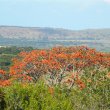

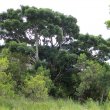
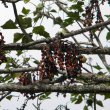
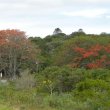
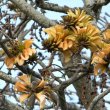



Comments
Erythrina caffra - will not flower
Hi, I have a Erythrina Caffra tree in our garden on Thesen Island, Knysna. It is about 7 years old and has not flowered. (My wife seems to think we may have had one flower but I do not recall)It is planted in sandy and therefore well drained soil. It is watered regularly via irrigation and has a number of indigenous plants around it, eg., strelitzia and clivias.In winter it receives early morning sun and full sun after lunch.Any ideas ?
Erythrina Caffra
we have 3 relatively young coral trees (Erythrina Caffra) in our garden. They are growing beautifully but only the youngest specimen flowers spectacularly. The 2 older trees (the biggest is about 4m in height)never get more than 4 or 5 flowers. What could the problem be?
Erythrina caffra: flowering
I have the same situation in my own garden. Only one of my Erythrinas ever flowers in all its glory. Some of the others make a partial attempt and others have never flowered at all. I have no idea why this is the case as in some areas of Bathurst and Grahamstown you can see almost all the trees in full flower. I do know that my garden is situated on a limestone ridge and the soil is slightly alkaline. Is salinity not perhaps the problem with the Thessan Island tree? Comparing the positions of my own trees, those in full sun and very dry areas flower better than those that receive some shade. None of them get more water than that which falls from the sky. Perhaps another reader can shed some light on this subject.
ERYTHRINA CAFFRA
I have a tree 3 feet from my house wall and six feet from the pool. It is about 15 m high and the branches are hanging over my roofs and I get no more sun, what should I do
Problem tree - Erythrina caffra
Hi Leon
Based on your description, there is only one suggestion I can offer: remove the tree!
Apart from the shade problem, the leaves collecting on the roof and dropping in the pool must be another constant problem with which you have to contend. But there are two other areas of concern.
For one, the wood of the Coral trees is very soft and porous, so there is always the possibility of a branch breaking off and damaging the roof, the house and even the people therein.
The second concern, and in my opinion the most worrying of all, is the root system. Erythrinas have aggressive and invasive root systems with roots that creep tightly along the walls of any close-by structures and under foundations and paving. Because this occurs out of sight, one may not become aware of the problem until it is too late. As the tree ages, the roots thicken considerably and start to nudge against foundations and walls. Eventually the damage will become evident in the form of cracks in walls, bulges in paving and leaks developing in pools.
The removal of a tree this size must be daunting and would have to be carried out with great care to prevent damage or injury. It would be best done in winter while the tree is leafless. Under no circumstances would I attempt to remove a tree in this position myself. It will be necessary to find a reliable tree removal company to carry out this procedure. Admittedly this is a costly undertaking but the possibility of damage to the house from falling branches and the injury or death of inexperienced workers must be taken into consideration.
Alternatively, you could poison the tree, but it will still have to be removed, with a greater chance of dried, brittle branches causing damage. You could also trim the branches - a huge undertaking in itself - but this is likely to stimulate the tree into more aggressive growth.
I do hope this information will help you to find a solution to your problem.
Kind regards
Lorraine
how to poison erythrina caffra, problem tree
Please can you advise how to poison Erythrina caffra? We have a problem tree too close to our house and it is breaking up the walls! We have tried pouring diesel into holes drilled into the trunk, but with no success.
Poison for killing trees
Hi Kathy
My first concern would be whether to poison the tree before cutting it down, or cut it down and then poison the stump. The wood of Erythrinas is soft, spongy and very brittle. When the branches dry out they will snap off and fall, which could cause severe damage to the house and possible injury to people or animals.
As to poisoning, let me start by saying that I have no personal experience with poisoning a tree so although I have spent a good few hours researching the subject, I cannot guarantee results. However, here are some pointers.
To kill the tree as it stands:
Mix 15 ml of Garlon with 1 liter of diesel and paint a band at least 250 mm wide all round the base of the trunk. (I guess you could also pour some of this mixture into the holes you have drilled.)
To kill the stump:
Cut the stump low down. Use either Garlon (15 ml mixed with 1 liter of diesel) or Roundup (30 ml mixed with 1 liter of water) and paint over the cut surface as well as a band around the stump.
Caution!
Follow the instructions on the package insert to the letter to prevent contamination of the area and the person involved in using the product.
Finally, be aware that as the roots rot away, the ground or foundation above them will collapse into the space left behind. This will reverse the cracking of the walls in the opposite direction so be ready to fill this cavity before even more damage is done.
You can buy the above mentioned products at most hardware stores, garden centers and stores like Game or Makro.
I hope this information is of some help. Removing a large tree invariably carries a potential for injury, so do take care.
Kind regards
Lorraine
How far from the house could I plat Erythrina Cafra
I obtained a small tree that I would like to plant in my garden without risk of damage to property in future.
What would a safe planting distance be from the house for Erythrina Cafra?
Erythrina caffra - planting distance from buildings
Hi Basson
A lot depends on where you stay. In areas where it is colder or drier it may be smaller than in an area with a warm, moist climate. This would influence the distance you could plant it from the house.
Erythrina caffra has a spread of 7 - 11 meters and roots that extend even further. Depending on where you live, I would suggest a minimum of 10 - 15 m from the house, making sure that it is the same distance away from any other permanent structures such as paving, walls, pools (and the neighbour's house!).
If you let me know where you live I will be able to make a more precise estimate.
Kind regards
Lorraine
Hallo,
Hallo,
Thank you.
I Stay in Durbanville and have seen the size of the tree in the local area. I have subsequently planted the tree 8 metres away from the nearest building and 6 metres from the nearest pavement. It should be OK for the next 25 to 30 years.
Basson
Erythrina caffra - comment on planting distance from buildings
Hi Basson
Thanks for your input. It is a really good idea to assess the potential size of the tree by comparing other specimens in your area, where this is possible. This certainly gives a much better measure than sheer guess work.
Regards
Lorraine
erythrina humeana
Realistically, how close can I plant an erythrina humeana to my house.
thanks
Erythrina humeana - size
Hi Ian
For myself, I would be prepared to plant a Dwarf Coral tree as close as a meter away from a wall. This really is a dwarf tree and is nowhere near as invasive as the bigger coral trees.
Apropos to our discussion, I did some research and came across some sites showing E. humeana as a big tree, for example "It measures 27 feet high, with a trunk circumference of 74 inches and a crown spread of 53 feet."
All these sites were overseas sites and I discovered that the trees shown are actually hybrids of humeana with other, larger coral tree species. There are no varieties or sub-species of this plant, other than those produced by human interference.
A true E. humeana remains small throughout its life. See http://www.plantzafrica.com/plantefg/erythrinahumeana.htm, for the most authentic description of this plant, from the South African National Biodiversity Institute (SANBI) - we can't argue with them!
Kind regards
Lorraine
Coral as a Bonsai
Hi. I have nurtured a coast coral seedling (the only seed that took out of nearly a 100 seeds!) It's a little over a year old now.
I have replanted it into a bonsai pot, as I plan to develop it into a bonsai in remembrance of my Dad who fought a 4 year battle with cancer and has passed in Feb of this year. He loved the coral tree and always wanted to have one as a bonsai, but never got around to grow that dream.
Now I have my seedling, growing nice and strong, but I am so careful with it, as I have tried to plant one from seed, many times before and failed. Do you have any suggestions on where to take my "tree" from here? Have you ever seen one as a bonsai?
I would love to look back 20 years from now, and think, "this tree I've grown from seed, and look at it now!"
Thank you in advance, hehe.
Michelle
Erythrina caffra as a bonsai
Hi Michelle
Unfortunately the input I can give you is not very encouraging, but don't let it put you off.
I did some research on this and in general it appears that this is one of the more difficult trees to bonsai. A friend of mine has had one for years but the leaves have never reduced. I bonsai'd a couple of Erythrina humeana (Dwarf coral tree)5 years ago and their leaves have just begun to reduce - see pic. below. As I know next to nothing about bonsai, I can't give you professional advice, so I searched through a number of sites and have included some comments and a couple of sites that may be of use.
The following link has some basic tips for bonsai beginners:
http://www.iol.co.za/lifestyle/home-garden/garden/branching-out-into-the...
This link has some specific information about growing Erythrina caffra as a bonsai.
http://www.ausbonsai.com.au/forum/viewtopic.php?f=38&t=2126
Comments:
http://www.capebonsaikai.co.za/articles/214-how-about-indigenous.html
"It looks like it would make a good bonsai but needs a lot of perseverance; leaves are very big and the growth habit is coarse. Try this one if you like a challenge!"
http://www.thegardener.co.za/kb/article.php?id=1001
"Erythrina caffra can produce...flowers, but it requires subtle techniques to coax even just a few buds out - even experienced bonsai growers struggle."
Erythrina lysistemon is apparently easier to grow as a bonsai, probably because it is a much smaller tree.
With reference to the poor germination of your seeds: the seeds must be soaked in warm water - I keep them in a thermos flask overnight. Throw out any seeds that float. Then use a pin or small, sharp knife and pierce the skin, well away from the 'black spot', which is where the root will appear. Plant in well drained soil and don't over water as the seeds will rot. Done this way I invariably have 100% germination.
I hope you find some useful information and persevere. You can also Google 'bonsai beginner' for more information.
Kind regards
Lorraine
coral tree
I bought a 4 year old bonsai coral from a nursery. How often should i water and how much. How much furtelizer, what type and how often should i feed it. Thank you. Maarten
Coral tree bonsai care
Hi Maarten
Bonsai is not my area of expertise. I suggest you Google 'Coral tree bonsai care' - I am sure you will find all the information you need.
Kind regards
Lorraine
Erythrina caffra doesnt flower
I have a coral tree which is about 4 years old . it has grown well and looks healthy but has never shown a sign of flowers . i am wondering if i just have a dud tree and remove it , or give it more time. Near George , WC . other trees nearby flower well
No flowers on Coral tree
Hi Andrew
I have seldom been able to find information relating to how old certain trees should be before they come into flower, so I can't give you a specific age.
However, the Coral trees that I planted some 5 years ago in my garden have not yet flowered. This stands true for seedlings that have sprung up in my piece of veld, some of which are older than 6 years, but have also shown no sign of flowers.There is one that I estimate at about 10 years old, that flowered for the first time this year.
This slow progress may arise from the fact that my garden is dry and the soil is not of the best quality. As George gets far more rain and growing conditions are probably better, your tree may flower sooner.
I wouldn't remove the tree - give it another three to four years.
Kind regards
Lorraine
Flowering of E Caffra
I planted a specimen purchased from my local nursery in Fish Hoek some 10 years ago and it did not flower for a good few years. However, the number of flowers has increased dramatically over the past three years. Patience seems to be required!
large Coral Tree cuttings
Hi,
I'm a beginner bonsai grower and I'm interested in getting my hands on some large Coral Tree branches to start off as pre bonsai material. If anybody in the Johannesburg area has a Coral Tree and is willing to part with a few large branches, please let me know. Thank you.
Discuss this plant
Share knowledge, ask a question or give an experience.